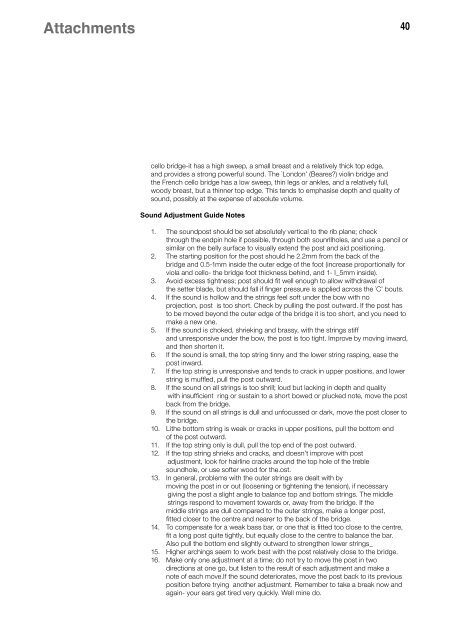advanced violin restoration techniques - International Specialised ...
advanced violin restoration techniques - International Specialised ...
advanced violin restoration techniques - International Specialised ...
You also want an ePaper? Increase the reach of your titles
YUMPU automatically turns print PDFs into web optimized ePapers that Google loves.
Attachments<br />
cello bridge-it has a high sweep, a small breast and a relatively thick top edge,<br />
and provides a strong powerful sound. The `London’ (Beares?) <strong>violin</strong> bridge and<br />
the French cello bridge has a low sweep, thin legs or ankles, and a relatively full,<br />
woody breast, but a thinner top edge. This tends to emphasise depth and quality of<br />
sound, possibly at the expense of absolute volume.<br />
Sound Adjustment Guide Notes<br />
1. The soundpost should be set absolutely vertical to the rib plane; check<br />
through the endpin hole if possible, through both sounrllholes, and use a pencil or<br />
similar on the belly surface to visually extend the post and aid positioning.<br />
2. The starting position for the post should he 2.2mm from the back of the<br />
bridge and 0.5-1mm inside the outer edge of the foot (increase proportionally for<br />
viola and cello- the bridge foot thickness behind, and 1- I_5mm inside).<br />
3. Avoid excess tightness; post should fit well enough to allow withdrawal of<br />
the setter blade, but should fall if finger pressure is applied across the `C’ bouts.<br />
4. If the sound is hollow and the strings feel soft under the bow with no<br />
projection, post is too short. Check by pulling the post outward. If the post has<br />
to be moved beyond the outer edge of the bridge it is too short, and you need to<br />
make a new one.<br />
5. If the sound is choked, shrieking and brassy, with the strings stiff<br />
and unresponsive under the bow, the post is too tight. Improve by moving inward,<br />
and then shorten it.<br />
6. If the sound is small, the top string tinny and the lower string rasping, ease the<br />
post inward.<br />
7. If the top string is unresponsive and tends to crack in upper positions, and lower<br />
string is muffled, pull the post outward.<br />
8. If the sound on all strings is too shrill; loud but lacking in depth and quality<br />
with insufficient ring or sustain to a short bowed or plucked note, move the post<br />
back from the bridge.<br />
9. If the sound on all strings is dull and unfocussed or dark, move the post closer to<br />
the bridge.<br />
10. Lithe bottom string is weak or cracks in upper positions, pull the bottom end<br />
of the post outward.<br />
11. If the top string only is dull, pull the top end of the post outward.<br />
12. If the top string shrieks and cracks, and doesn’t improve with post<br />
adjustment, look for hairline cracks around the top hole of the treble<br />
soundhole, or use softer wood for the.ost.<br />
13. In general, problems with the outer strings are dealt with by<br />
moving the post in or out (loosening or tightening the tension), if necessary<br />
giving the post a slight angle to balance top and bottom strings. The middle<br />
strings respond to movement towards or, away from the bridge. If the<br />
middle strings are dull compared to the outer strings, make a longer post,<br />
fitted closer to the centre and nearer to the back of the bridge.<br />
14. To compensate for a weak bass bar, or one that is fitted too close to the centre,<br />
fit a long post quite tightly, but equally close to the centre to balance the bar.<br />
Also pull the bottom end slightly outward to strengthen lower strings_<br />
15. Higher archings seem to work best with the post relatively close to the bridge.<br />
16. Make only one adjustment at a time; do not try to move the post in two<br />
directions at one go, but listen to the result of each adjustment and make a<br />
note of each move.If the sound deteriorates, move the post back to its previous<br />
position before trying another adjustment. Remember to take a break now and<br />
again- your ears get tired very quickly. Well mine do.<br />
40

















